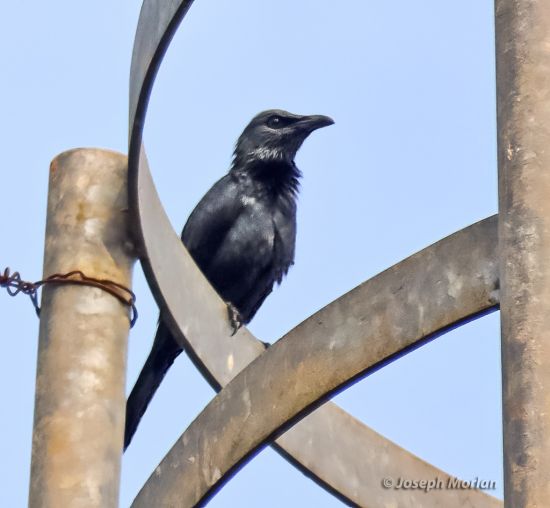
Jikotamo, Obi Island, South Halmahera Regency, North Maluku, Indonesia,
14 November 2023.
Alternative name: Island Starling
- Aplonis mysolensis
Identification
20cm. A medium-sized starling with a fairly long, graduated tail.
- Mostly black plumage with green-purple gloss
- Duller wings and tail
- Bristly feathers on forehead, lanceolate (but not elongated) feathers on neck and throat
- Brown eye
- Black bill and legs
Sexes similar. Juveniles have a shorter tail, are chocolate-brown and appear heavily streaked on underparts.
Distribution
Found in the northern Moluccas, Indonesia. Present on Banggai Islands, Sula Islands, Morotai, Halmahera, Ternate, Bacan, Obi, Buru, Seram, Ambon, Haruku, Saparua and on the West Papuan Islands (Gebe, Waigeo, Ajoe, Batanta, Salawati, Misool and some smaller islets).
Common on most islands.
Taxonomy
Subspecies
Clements recognizes 2 subspecies[1]:
- A. m. sulaensis:
- East Sulawesi, Banggai Islands and Sula Islands
- A. m. mysolensis :
- Moluccas and western Papuan islands
IOC considers this species to be monotypic [3]
Birds from Banggai are sometimes treated as subspecies persimilis, from Sula as sulaensis and from Halmahera as forsteni. However, most checklists don't accept these subspecies.
Habitat
Lowland forest, coastal forest, mangroves and hill forest. Also in degraded areas, cultivated areas, scrub and in villages and some towns with big trees.
Behaviour
Diet
Feeds on fruit. Takes probably also insects and nectar.
Forages usually in flocks, sometimes in pairs or singly. Associates with Metallic Starling.
Breeding
No information on breeding season. Presumed to form monogamous pairs. Nests in colonies of up to 50 pairs, sometimes more. The nest is placed in a tree hole.
Movements
A resident species.
References
- Clements, J. F., P. C. Rasmussen, T. S. Schulenberg, M. J. Iliff, T. A. Fredericks, J. A. Gerbracht, D. Lepage, A. Spencer, S. M. Billerman, B. L. Sullivan, and C. L. Wood. 2023. The eBird/Clements checklist of Birds of the World: v2023. Downloaded from https://www.birds.cornell.edu/clementschecklist/download/
- Del Hoyo, J, A Elliott, and D Christie, eds. 2009. Handbook of the Birds of the World. Volume 14: Bush-shrikes to Old World Sparrows. Barcelona: Lynx Edicions. ISBN 978-8496553507
- Gill, F, D Donsker, and P Rasmussen (Eds). 2024. IOC World Bird List (v 14.1). Doi 10.14344/IOC.ML.14.1. http://www.worldbirdnames.org/
Recommended Citation
- BirdForum Opus contributors. (2025) Moluccan Starling. In: BirdForum, the forum for wild birds and birding. Retrieved 13 May 2025 from https://www.birdforum.net/opus/Moluccan_Starling
External Links
GSearch checked for 2020 platform.1



